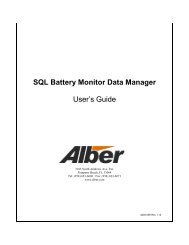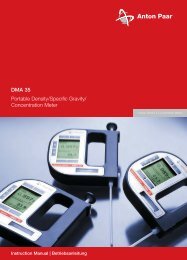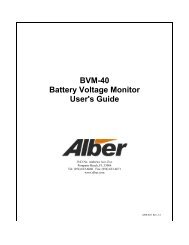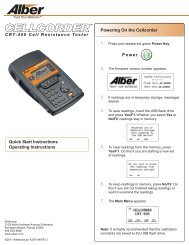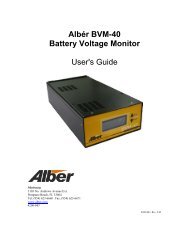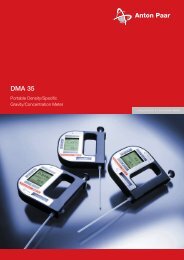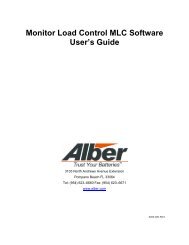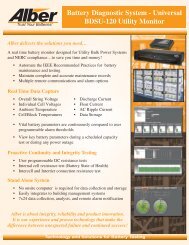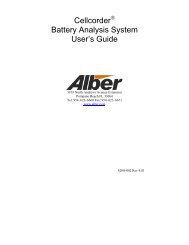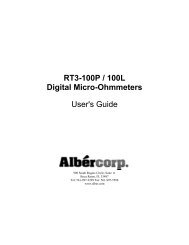BCT-2000 Software and BCT-128 and BCT-256 User's Guide - Alber
BCT-2000 Software and BCT-128 and BCT-256 User's Guide - Alber
BCT-2000 Software and BCT-128 and BCT-256 User's Guide - Alber
- No tags were found...
Create successful ePaper yourself
Turn your PDF publications into a flip-book with our unique Google optimized e-Paper software.
9. Recommended TestsPrior to performing any type of battery test, you should review battery theory <strong>and</strong> the batterymanufacturer's maintenance <strong>and</strong> test procedures. Albércorp strongly recommends following theIEEE Std 450-1995 publication on battery maintenance <strong>and</strong> testing for flooded cells, <strong>and</strong> IEEEStd 1188-1996 for VRLA batteries. By using the battery manufacturer's suggested testingprocedures <strong>and</strong> those issued by IEEE, you can help ensure a safe, effective load test.Before performing a load test, determine the type of test to perform, the length of the test, <strong>and</strong>where to locate the equipment during testing. If the test includes the use of Albércorp DC loadbanks, a well-ventilated area is required to disperse heat from the resistive load bank. In mostcases, the <strong>BCT</strong>-<strong>128</strong> or <strong>BCT</strong>-<strong>256</strong> is placed near the battery being tested, <strong>and</strong> the load bank iswithin 50 feet of the battery <strong>and</strong> <strong>BCT</strong>.WARNING: Do not place the load bank in a room that has an automatic halon (or other) firesystem. The heat generated by the load bank could inadvertently trigger the fire system. Eitherlocate the load banks in a safe area without such a system, or take other measures to prevent theinadvertent activation of the automatic system.Before connecting the <strong>BCT</strong>-<strong>2000</strong> to the battery being tested, <strong>and</strong> prior to any load testing,Albércorp recommends performing the following tests on the battery.9.1. Micro-OhmmeterDuring the battery discharge test, the test system discharges the battery at a high current rate.Ohm’s Law shows that a high rate of current through a high resistive connection results in alarge amount of power being dissipated through the connection. This could cause excessiveheat build-up <strong>and</strong> result in premature termination of the test. Therefore, use amicro-ohmmeter to ensure there are no high resistive connections between individual cells,modules or intertier connections. Refer to the battery manufacturer's maintenance instructionsfor a safe range of readings.9.2. HydrometerPrior to load testing, read the specific gravity of the sample electrolyte to confirm the batteryis fully charged. Reading cannot be performed on sealed cells, but can easily be done on wetcell batteries. Although this data is not entered into the <strong>BCT</strong> program, you may want torecord it separately <strong>and</strong> attach it to the final test report. Specific gravity is a good indicator ofthe present charge of the battery. If all cell float voltage readings are within normal limits,you may limit the hydrometer readings to a 10% sample.9.3. Temperature (Electrolyte)While taking specific gravity readings, measure the electrolyte temperature of each cell.Record this data <strong>and</strong> then calculate the average temperature of the electrolyte in the cellsbeing tested. The <strong>BCT</strong>-<strong>2000</strong> requires that the temperature be entered for certain tests. Usethis average value for temperature correcting the load during test setup.12



